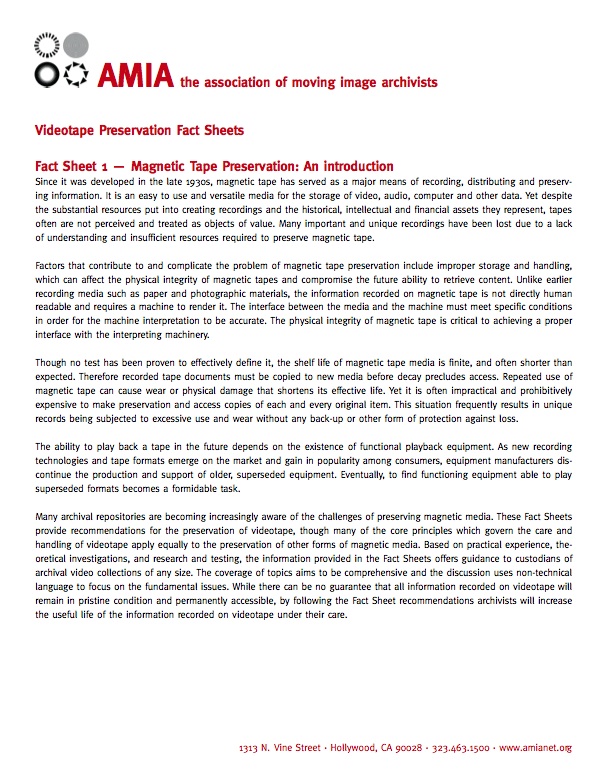-
-
-
-
-
-
-
-
-
-
-
-
-
-
-
-
+
-
-
-
-
-
-
-
-
-
-
-
-
+
-
+
-
-
-
-
-
-
-
-
-
-
-
-
-
-
-
Inspection at Intake/Cataloging
Inspection is the process of gathering detailed information about tape condition in preparation for migration to new formats, as well as to check the status of tapes already preserved or yet to be preserved.
Inspection at Intake/Cataloging
A detailed physical inspection of video materials can provide a great deal of information and help vendors determine what steps are necessary to migrate the tape to a new format. Tape inspection is a relatively straightforward process, but it needs to be done in an orderly fashion, with careful attention to details. A basic videotape inspection form can be found in the condition report section of this website.
See document at bottom for The Association of Moving Image Archivists' Guide to Videotape Inspection for a step-by-step guide to physical inspection. Visit The Association of Moving Image Archivists' website to discover more about their organization.
In general:
· Inspect the physical condition of each tape as you inventory and prepare it for long-term storage.
· Identify tapes that will need more immediate attention and determine which tapes are high, mid, or low preservation priorities.
· Document your observations and assessments in the catalog.
Signs of Active Deterioration or Potential Damage
· A pungent vinegarlike smell-vinegar syndrome
· White or brown mold (SEE ADVISORY BELOW REGARDING MOLDY TAPES)
· White or brown powder on the end of the tape or inside the container
· Tape stickiness-evidence of sticky shed syndrome
· Dirt, dust, or fingerprints-evidence of improper handling
· Reel stored loose or unevenly wound
· Severe damage (including water damage) to the tape case
Handling Techniques
· Wear lint-free gloves and try not to touch the tape surface or the edge of the pack.
· Handle tapes in clean areas that are free of dust, smoke, and food. (Fingerprints, dust, or debris can result in dropout if the particles get between the head and the tape).
· Tapes that are contaminated with vinegar syndrome or mold should be separated from other tapes and kept cool and dry, because the acetic acid or spores infecting these tapes can spread and infect healthy tapes.
An important note regarding moldy tapes: Mold can present serious health hazards. If mold is encountered during the inspection process, stop the inspection immediately. Isolate the tape until it can be examined by an expert who can identify the type of mold and ensure that the tape is safe to handle.
Ongoing Periodic Inspection
· It is a good idea to implement a regular inspection program and assess the physical condition of your tapes. Ideally, they should be inspected at least every six months so that you can identify early signs of deterioration.
· It is recommended that you exercise your tapes-i.e., rewind them-every three years. This relieves tape pack stresses.
· After exercising a tape, be sure you restore the tape with an even wind, on the appropriate hub (take-up hub for consumer formats; supply hub for non-consumer formats).








